The current trip to Tokyo has been decided since a month ago and took one week in the planning. It has been especially timed such that it coincide with the Sakura opening season in Tokyo. As reservation are required for the bus ride from Koriyama city to Tokyo, the return tickets were bought on Thursday evening at a cost of 7,200 Yen. The top sights in Tokyo Central were researched and narrowed down based on information provided by Lonely Planet Tokyo, japan-guide.com and Yes!Tokyo. After some discussions with a local guide, the top sights to be visited are as follows:
1. Ikebukuro (Day 1)
- Ikebukuro (One of Tokyo's multiple city centers)
2. Ueno (Day 1)
- Ameyoko (Busy market street in Ueno)
- Yushima (Shrine for the God of Learning)
- Ueno Park (Public park full of museums and other attractions)
- Kaneji Temple (Tokugawa family temple)
3. Akihabara (Day 1)
- Electric City
4. Asakusa (Day 1)
- Asahi Breweries Ltd (Headquarters of the Asahi beer)
- Sensoji Temple (Large temple in Asakusa area)
- Asakusajinja (Traditional shinto temple next to Sensoji Temple)
5. Odaiba (Day 1)
- Rainbow Bridge (Majestic bridge linking Odaiba to Tokyo Central)
- Fuji TV Headquarters (One of Japan's main broadcasting station)
- Palette Town (Toyota City and indoor-sky shopping mall)
- Oedo Onsen Mongatari
6. Tsukiji Fish Market (Day 2)
- Tsukiji Fish Market (One of the world's largest fish markets)
- Sushi Breakfast at Tsukiji Fish Market
7. Imperial Palace (Day 2)
- Hibiya Park
- Imperial Palace
- Palace East Gardens
- Yasukuni Shrine
8. Ginza (Day 2)
- Ginza (Famous shopping and entertainment district)
9. Harajuku (Day 2)
- Harajuku (Japan's teenager capital)
- Meiji Shrine (Shrine dedicated to the deity of Emperor Meiji)
10. Shibuya (Day 2)
- Shibuya (Busy district for younger generations)
11. Shinjuku (Day 2)
- Shinjuku (Large entertainment, shopping and business district)
All the places mentioned above can be summarised onto the map below. It follows a general clockwise route.
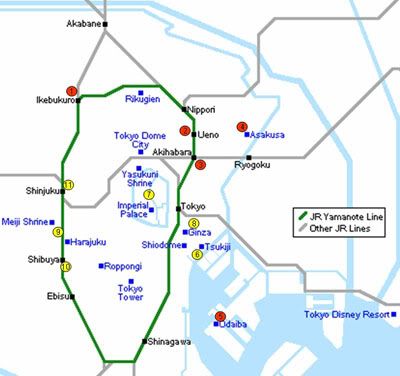
1. Ikebukuro City
We met up early on Saturday morning at 6.30am and proceed on to the bus station which is a 5 minutes walk away. The bus departs at 6.50am and is expected to reach Ikebukuro at 10.20am. There are two buses travelling to Tokyo at this time with another two more stops after Koriyama station for the boarding of passengers. The buses were almost fully-packed.
There were two pit-stops along the way for passengers to revitalise a bit. Along the way to Tokyo, we were caught in a jam and the arrival time was eventually delayed by an hour; reaching Ikebukuro at 11.20am instead. Ikebukuro is where the local guide used to live when he was in Tokyo. It is quite a busy city and is quite a good introduction to Tokyo city.
We stopped by a Tourist Information Center and acquire some maps and information about Tokyo before proceeding on by densha to Ueno station.
2. Ueno
It is said that Ueno and Asakusa are the only two places that preserve the traditional look and feel of Tokyo. So here we are at Ueno, the second stop for the day. The station is large and equally busy. We left the station through the south entrance and on to Ameyoko market. It is a busy market which sells cheap produce and fashion wear. Vendors can be seen hawking their wares throughout the streets with the cheers occasionally broken by the sounds of densha running above.

Once the sights of Ameyoko market has been captured, we made a right (East turn) towards the direction of Yushima shrine. This shrine is a very popular shrine amongst students who come regularly to ask for blessings in their studies. In it enclose the God of Studies. It is quite off the beaten track, located in a quiet part of Ueno district.
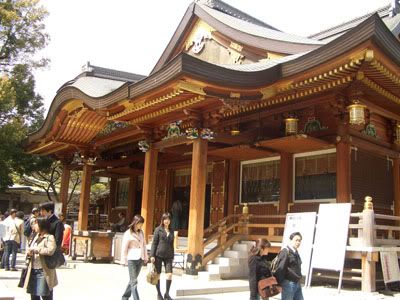
Many people can be seen hanging their well-wishes onto the boards around the temple.
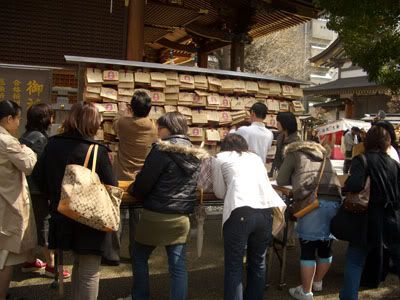
The next stop is Ueno park. It is a truly a beautiful park with throngs of people strolling around and catching the cherry blossoms. They call it hanami in Japanese, which means observing the flowers. Most of the people setup picnic areas in the park and just sit back, relax and enjoy a snack or two. The weather is splendid and feels like in a air-conditioned environment. With the park completely surrounded by beautiful blossoms, it really feels like being in paradise.
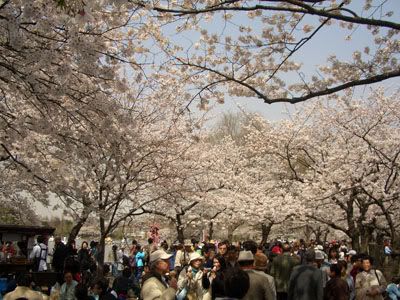
Here is a close up view of the Sakura.
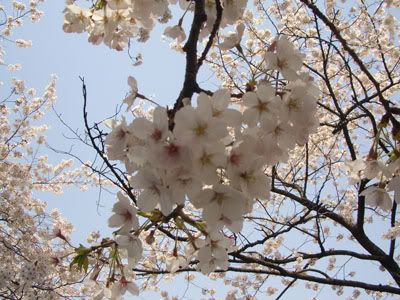
We decided to join the locals and bought our lunch in the park; thereafter just sit back and observe the blossoms.
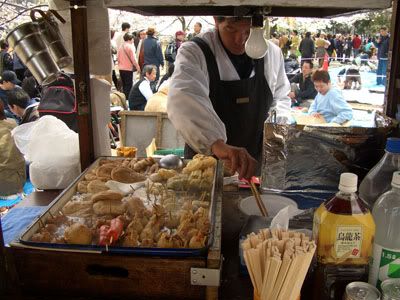
Along the way, we grabbed a few more bites from the stalls that dotted the park. The crowd increased tremendously as we made our way towards the central park which is just next to the subway exit. We have to run up to a temple for refuge. It is equally packed but much less than what we have encountered. I noticed the temple (清水观音堂) is dedicated to the Bodhisattva of Compassion. It is not indicated on the map. A lot of people are making offerings to the main Kannon representation. I stood aside waiting for the crowd to clear and noticed a light offerings chamber to one side. I threw in a few hundred yen and lighted two candles. This is the first time I am making light offerings in a temple. The feeling is really unique. I suddenly recalled a teacher saying that making of light and water offerings is very much more positive than making of money offerings. It is till now that I realise why.
We proceeded on from the temple to the rest of the park. The paths widen into the garden square where visitors can have a good view of all the trees and museums in Ueno park. There are performance and stage plays at different ends of the square. We walked north through the park and arrived at Kaneji Temple. It is a quiet and peaceful temple that is used by the Tokugawa family. The sakuras are especially beautiful in this temple against the tranquil backdrop provided by the temple.
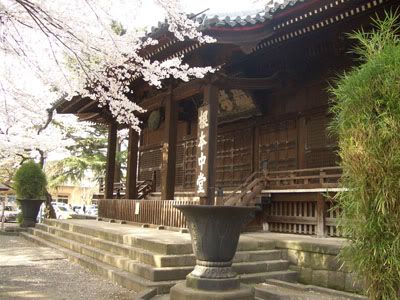
3. Akihabara
The next stop is Akihabara which is only a 10 minutes ride away. It is the electronics and computer shopping area of Tokyo. A must come for all technology-enthusiasts. While walking along the main street, I noticed there are a large number of hobby shops to the side. We made a round through the main streets to the back streets, delving into one of the many computer shops and checking out what is available in there. The final stop in Akihabara is the electric city, which is a 10-over storey building which sells every kind of electronic gadget and equipment. A down side to this is the incompatibility of the products to the Singapore's 240V standard. So we can only 'oooh' and 'arrrr' at all the high-tech stuff and not be able to get it.

4. Asakusa
The last stop today in Tokyo central is Asakusa. Upon arriving at the station, we proceeded on towards the direction of the ferry terminal. There is another beautiful sakura park next to the ferry terminal and from there we can get a splendid view of the Asahi building. The building is shaped like the Asahi beer.
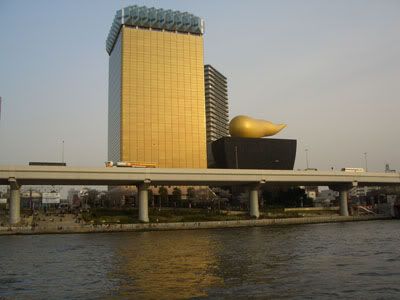
We made a turn towards the old streets of the Asakusa temple. Walking through the recommended shopping street which lead to the temple.
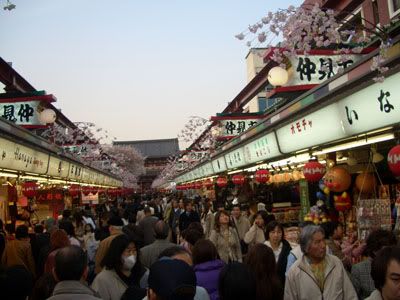
Here is the picture of the famous large lantern in the middle of the temple gate.
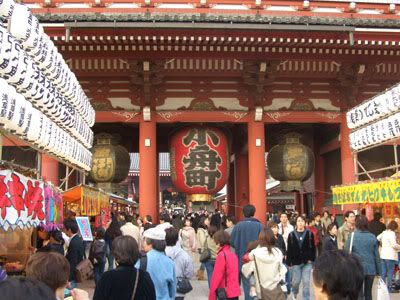
In the temple, we noticed the devotees are collecting the heat from the extinguished incense and spreading through them.
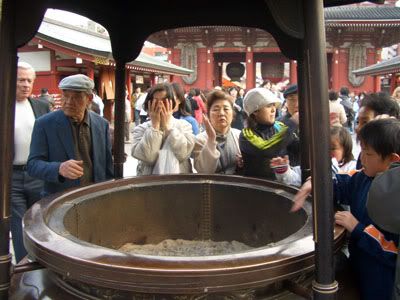
A long queue leads to the main shrine of the temple where devotees throw in their donations.
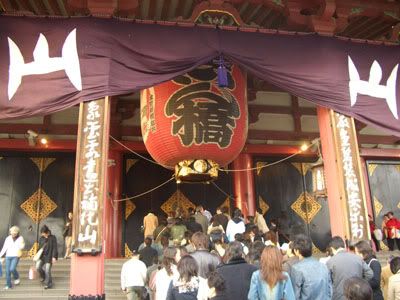
5. Odaiba
And here we are enroute to the last stop for the day at Odaiba. It is located a distance from Tokyo central on an island paradise (as it is called by the locals). We took the Asakusa line and transit to the Yurikamome Line. The Yurikamome is something like the LRT system in Singapore and is driverless. On the carriage, we befriended a local who is very enthusiastic in showing us along the coast of Odaiba. We found out that he lives in one of the condos next to the coast and is actually a Director of a FTA Company in Odaiba. Here is a photo which I took together with him.
The night scene of rainbow bridge from Aqua City Odaiba is stunning. As the coastal winds are strong, it took us over 10 minutes to get a perfect shot of the bridge.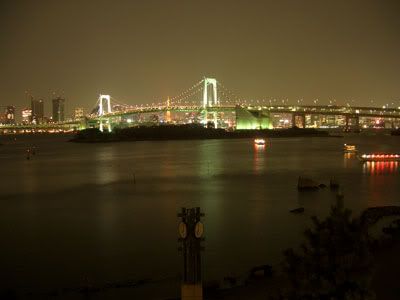
Here is a view of the legendary Fuji Television. Wonder is Kimura Takuya in there...
We walked through the Promenade Park to the other end of Odaiba and arrived at Palette Town. A large and futuristic shopping mall in the island. In it there is Toyota city. I was especially drawn to the Lexus series and decided to go for a test drive.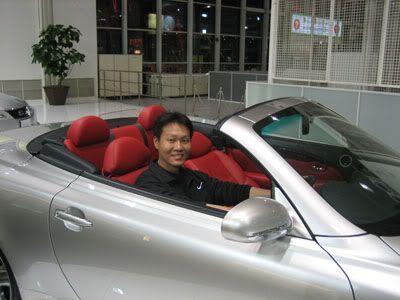
Just next to the Toyota city is a beautiful shopping mall which has an Italian theme to it. The scene belows look like the Trevi fountain in Rome. The top of the mall has an indoor sky that moves so it really gives an impression that it is still day.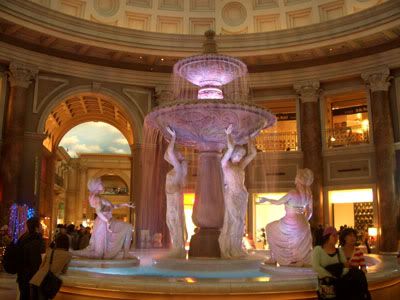
It is coming close to 8pm and we decided to adjourn to the final destination for the day. It is Oedo Odaiba Onsen. We have been hearing much about this Onsen from our colleagues for a year now and we are finally here.
We were welcomed into the onsen and were given a variety of Yukata to change into.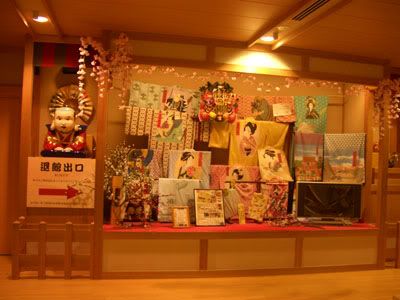
We went for the indoor and outdoor baths. The feeling of being in a outdoor bath is really unique. Just a water surface difference, the body feels hot and cold at the same time. After an hour of relaxing bath, we changed back into our yukata and prepared for dinner. The main street in the Onsen is mirrored after the look and feel of the Edo period. 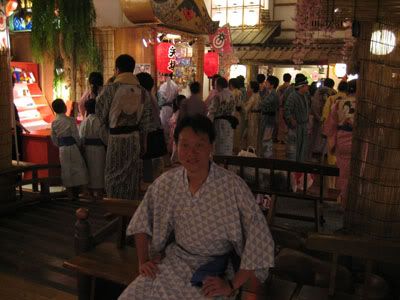
A quick snapshot of the main street and the dining area. We will also be spending overnight here. Beds have been setup for us which is good as from what I had heard previously, my colleagues have to sleep on the tatami with shared pillows. 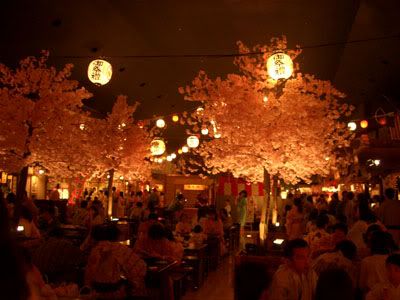
We woke up at 6am the next morning. Went for a morning onsen bath again and going for both the indoor and outdoor experience again. Took the LRT out of Odaiba. We took another beautiful shot of the rainbow bridge again below.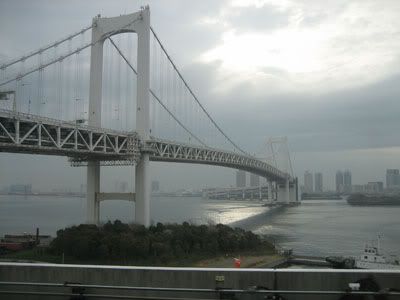
6. Tsukiji Fish Market
The first stop for the second day is Tsukiji Fish Market. There are probably hundreds of stalls here selling fresh catches from the sea. It is one of the largest fish market in the world. Even at the entrance, we sense a very strong smell of fish. Here is a quick snapshot of the busy market of Tsukiji.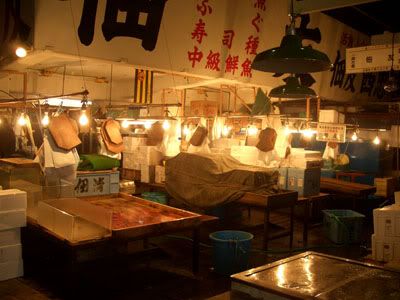
When in Tsukiji Fish market, the most important thing we have to do is to savour the fresh catch of the day at one of the hundreds of sushi outlets. We went to one of the shops below: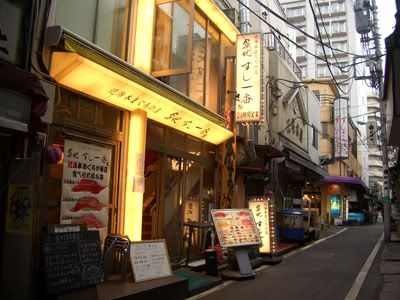
We placed our orders through the picture menus. The chef is seen carefully preparing the various orders.
Here is what I have ordered. A complete seafood crusine for the breakfast.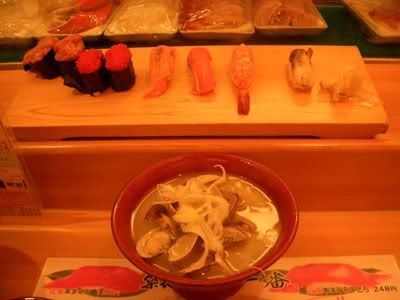
After breakfast, we walked down the road towards Tsukiji subway. We noticed this fascinating building to the side. From the map it says it is Honganji Temple but it looks like a church. We were greeted by signs of welcome at the entrance of the big building. The inner design also looks and feel like a catholic church. With the exception of an incense pot and altar at the front of the hall.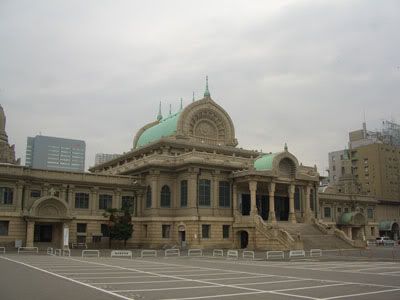
I sat down at one of the many chairs and read about the history of the Tsukiji Honganji temple. This temple is designed based on Indian architecture. Now come think of it, it does looks Indian. A quick peek into the main shrine below. It has a representation of Amitabha Buddha. 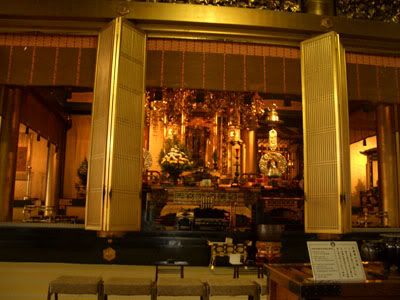
7. Imperial Palace
As it is still early in the day, we decided to proceed on to the Imperial Palace instead of Ginza. The first sight as we came out of the station is the beautiful Hibiya Park which is next to the Imperial Palace grounds. The flowers are blooming in this garden with a Bonsai feel to all the trees. It is nice to just sit down at one of the park chairs and just watch the flowers. 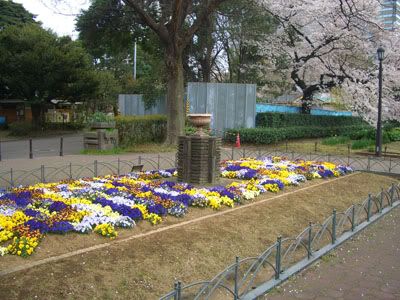
We took a 20 minutes walk through the garden and emerged straight to the Imperial palace grounds. It is a tremendously large open space as much as the eye could see. My camera could only capture that much. Being in this large open space really opens up the heart too.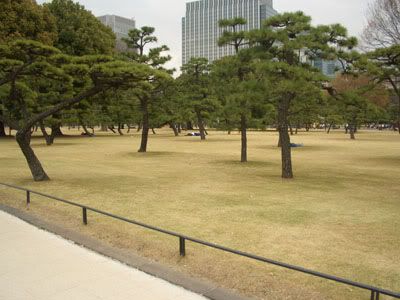
We walked around the palace grounds, taking photos along the way. Here is a scene of Edo Castle.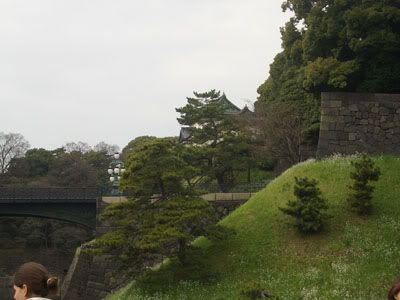
We proceeded northwards through the Imperial Palace East Gardens. And even further north to the final destination of the Palace gardens tour, the infamous Yasukuni Shrine. This place looks like just any other tourist attraction with food stalls lining the entrance. 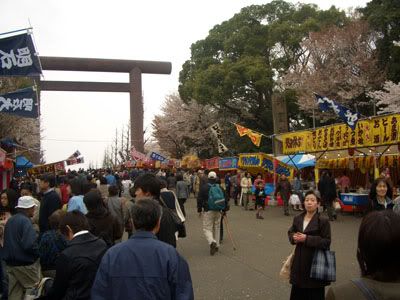
There is even a concert celebration for Sakura opening in between the first entrance and the second entrance. The group below looks like Morning Musume which has 14 members in all. Kawaii-desu!!! The video of the performance can be seen below.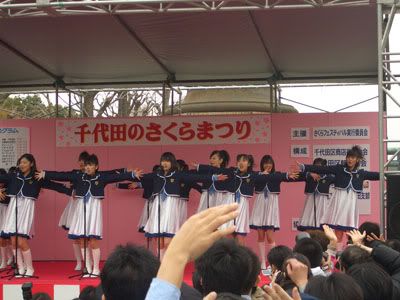
There is a monkey show just directly outside the Yasukuni temple. haha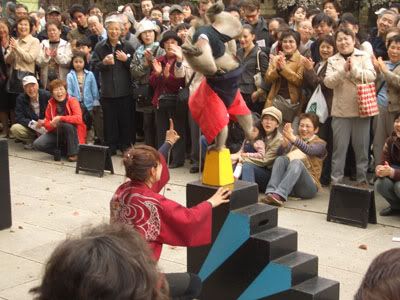
Here is the main shrine. It feels like just any other shinto temple. With long queues of people throwing money into a box in front of the shrine. Next to it is a museum which reveals its dark secrets. The real zero fighters, mortar guns and books advocating Japan's WWII might are displayed in there.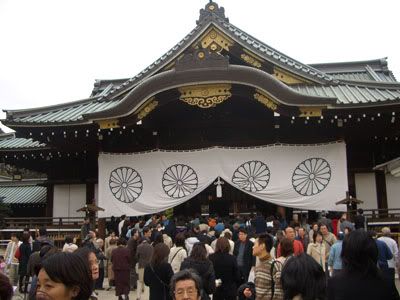
8. Ginza
The posh shopping district of Japan is up next. The popular Ginza shopping district. Suitable for sophisticated and executives shoppers. I don't do much shopping myself, so we just stroll through the main Ginza area. The entire road is closed to accommodate the large numbers of shoppers.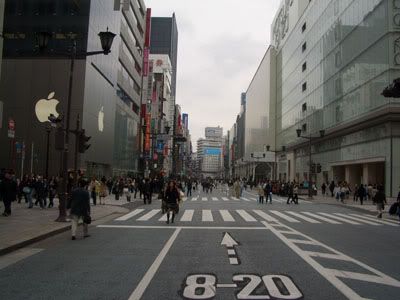
9. Harajuku
Next stop: Harajuku. But we alighted at Omotesando as we heard it is another vibrant posh shopping area. Here is a scene at the busiest junction.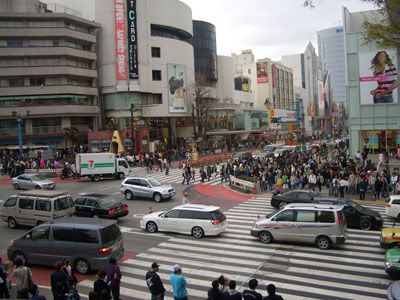
The entrance to the famous Harajuku shopping street. A place where youths check out their latest fashion wear. The inclination towards Western culture can be strongly felt in this street through songs, advertisements and displays. 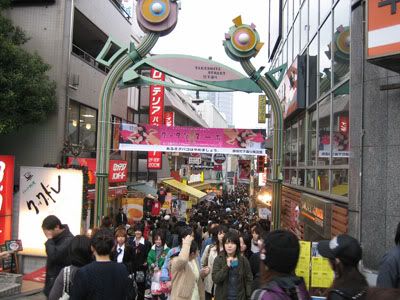
The famous Harajuku Kids 1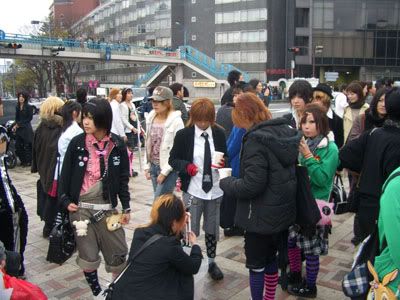
The famous Harajuku Kids 2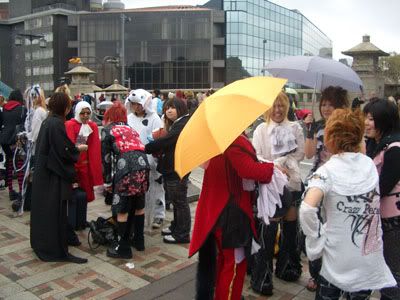
We visited the Meiji shrine which is a 10 minutes walk from Harajuku station. It is another peaceful shrine where we spent another 10 minutes resting and enjoying the moment.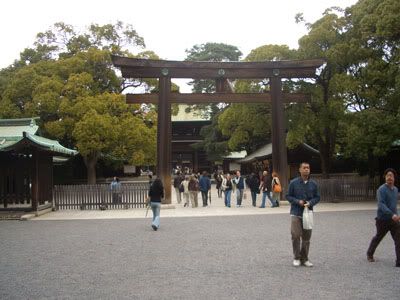
10. Shibuya
And here we are off down south, a station away from Harajuku: Shibuya. Showcase in the picture below is the popular junction where large crowds of pedestrians cross all over the junction. We have to be careful which direction we are walking or else a collision course will ensue. Shibuya is another great shopping area where a cool vibrancy of Tokyo can be felt here.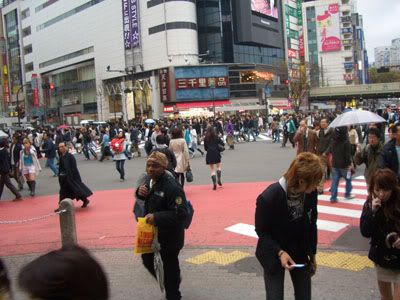
11. Shinjuku
Finally, last stop for the Tokyo trip is Shinjuku. It started drizzling and the sun is setting. We walked around the streets of Shinjuku for an hour. Going straight to the main highlights of this place. Here is a quick shot of the popular Kabuki-cho, Tokyo's notorious red light district.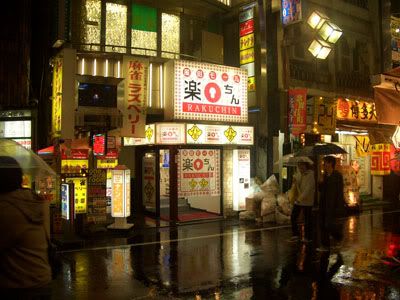
At the end of the walk round Shinjuku, we dine in for dinner at a Shapu Shapu shop.
Here is what we have ordered.